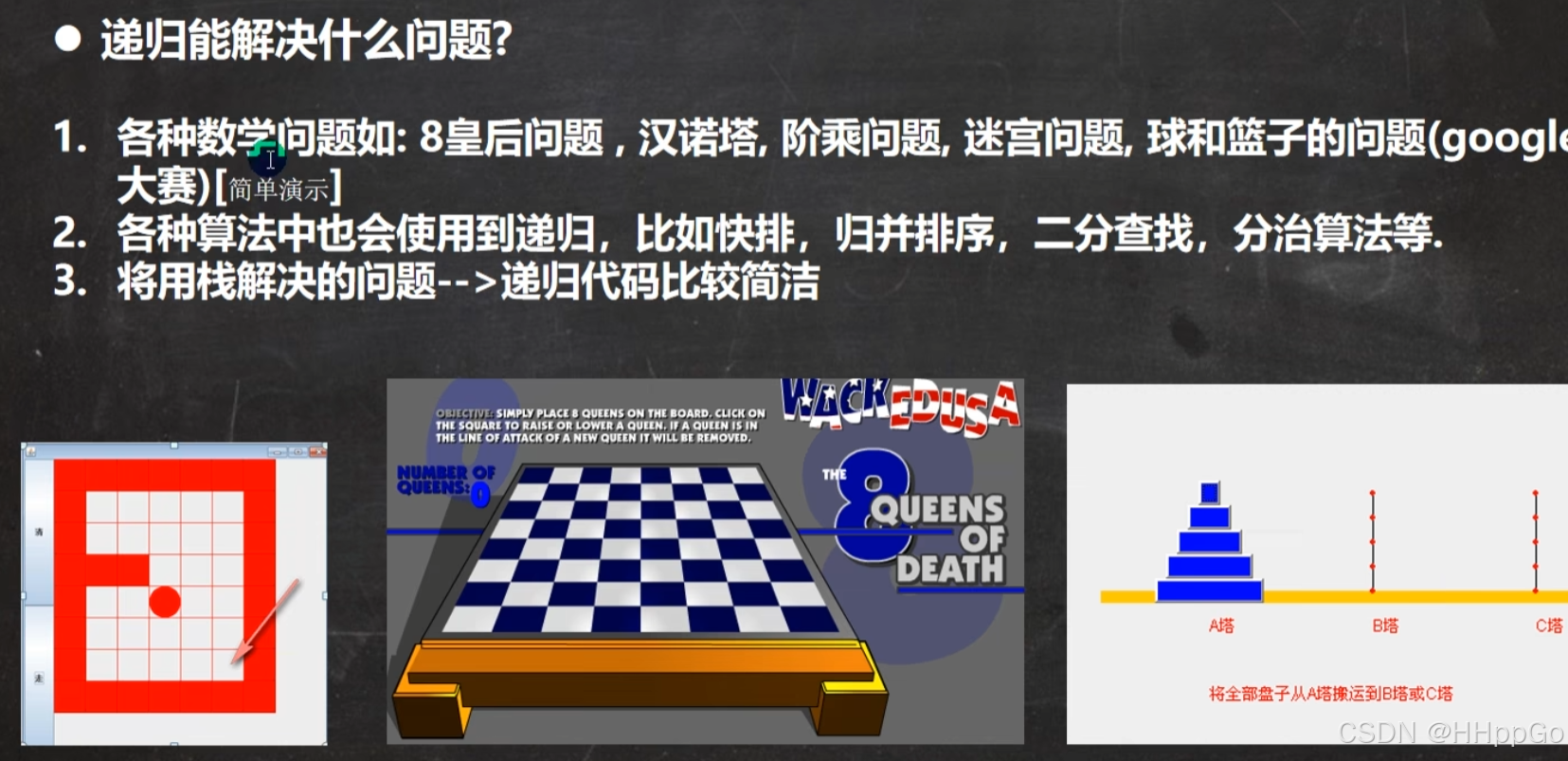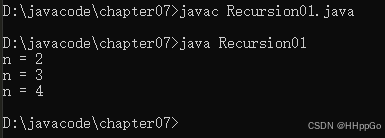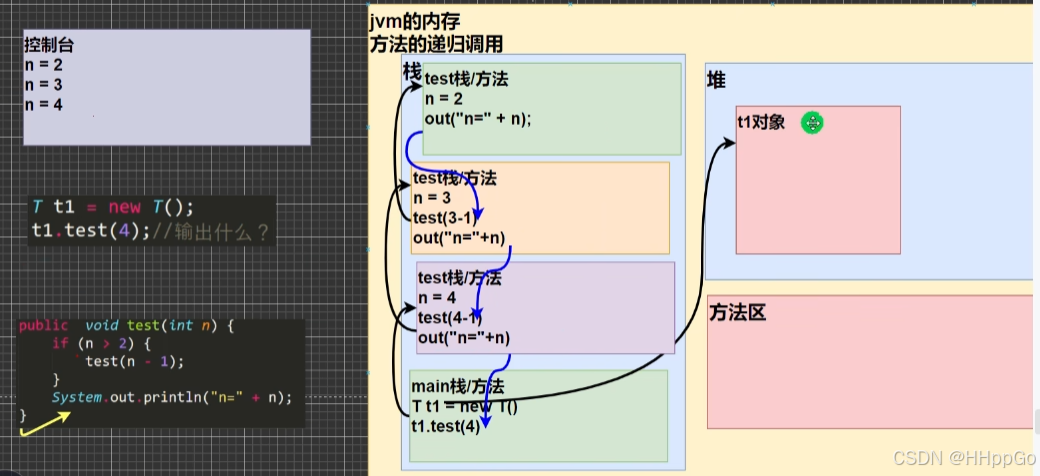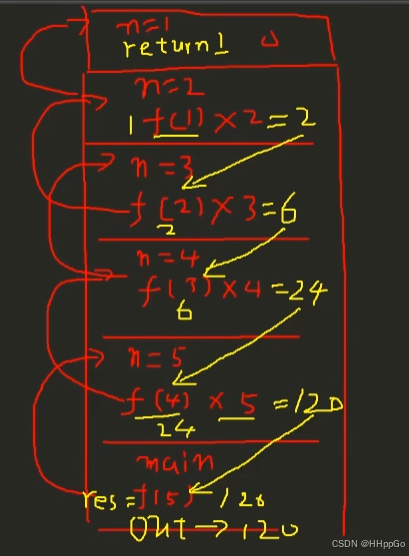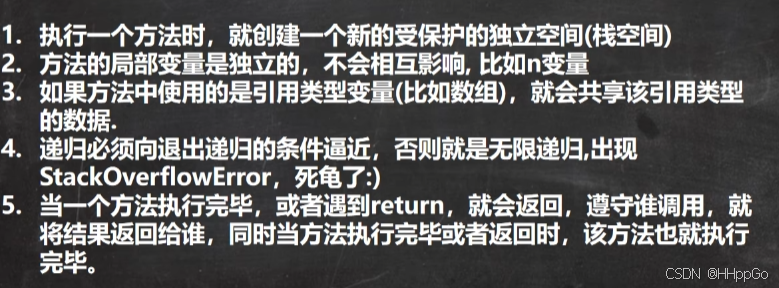基本介绍
简单的说: 递归就是方法自己调用自己,每次调用时传入不同的变量.递归有助于编程者解决复杂问题,同时可以让代码变得简洁
递归执行机制1——打印问题
public class Recursion01 {
public static void main(String[] args) {
T t = new T();
t.test(4);
}
}
class T {
public void test(int n){
if(n > 2) test(n-1);
System.out.println("n = " + n);
}
}
递归执行机制2——阶乘问题
public class Recursion01 {
public static void main(String[] args) {
T t = new T();
t.test(4);
int res = t.factorial(5);
System.out.println("res = " + res);
}
}
class T {
public void test(int n){
if(n > 2) test(n-1);
System.out.println("n = " + n);
}
public int factorial(int n) {
if (n == 1) {
return 1;
} else {
return factorial(n-1) * n;
}
}
}
递归重要规则
练习题——斐波那契数
/*
* @Author: Marte
* @Date: 2024-10-27 15:10:05
* @Last Modified by: Marte
* @Last Modified time: 2024-10-27 15:23:37
*/
public class RecursionExercise01 {
public static void main(String[] args) {
T t1 = new T();
int n = 7;
int res = t1.Fibonacci(n);
System.out.println("整数"+ n + "对应的斐波那契数是 " + res); // res = 13
}
}
class T {
/*
请使用递归的方式求出斐波那契数 1,1,2,3,5,8,13...给你一个整数 n,求出它的值是多
思路分析
1. 当 n = 1 斐波那契数 是 1
2. 当 n = 2 斐波那契数 是 1
3. 当 n >= 3 斐波那契数 是前两个数的和
4. 这里就是一个递归的思路
*/
public int Fibonacci(int n) {
if(n >= 1){
if (n == 1 || n == 2){
return 1;
} else {
return Fibonacci(n-1) + Fibonacci(n-2);
}
} else {
System.out.println("要求输入的n >= 1的整数");
return -1;
}
}
}
练习题——猴子吃桃子问题
public class RecursionExercise02 {
public static void main(String[] args) {
T t1 = new T();
int res = t1.peach(0);
if(res != -1)
System.out.println("第一天时的桃子数量为:"+ res);
}
}
class T {
/* 猴子吃桃子问题:有一堆桃子,猴子第一天吃了其中的一半,并再多吃了一个!
以后每天猴子都吃其中的一半,然后再多吃一个。当到第 10 天时,
想再吃时(即还没吃),发现只有 1 个桃子了。问题:最初共多少个桃子?
思路分析 逆推
1. day = 10 时 有 1 个桃子
2. day = 9 时 有 (day10 + 1) * 2 = 4
3. day = 8 时 有 (day9 + 1) * 2 = 10
4. 规律就是 前一天的桃子 = (后一天的桃子 + 1) *2//就是我们的能力
5. 递归*/
public int peach(int day){
if(day == 10){
return 1;
} else if(day >= 1 && day <= 9) {
return (peach(day+1) + 1) * 2;
} else {
System.out.println("day在 1- 10");
return -1;
}
}
}
